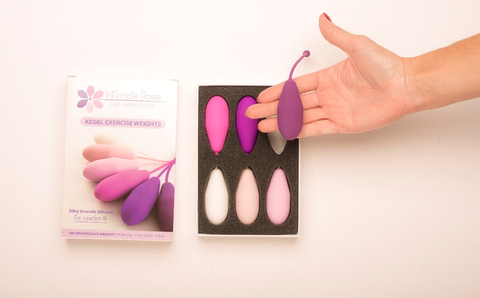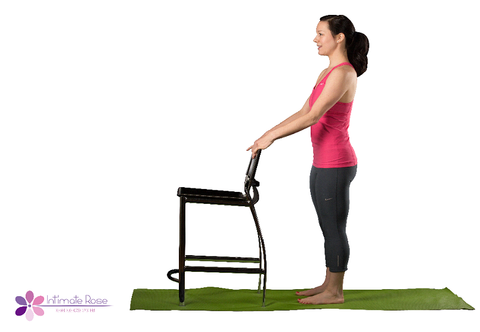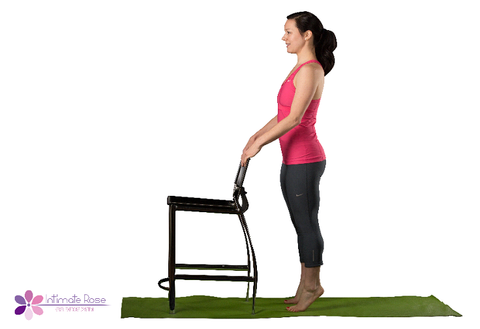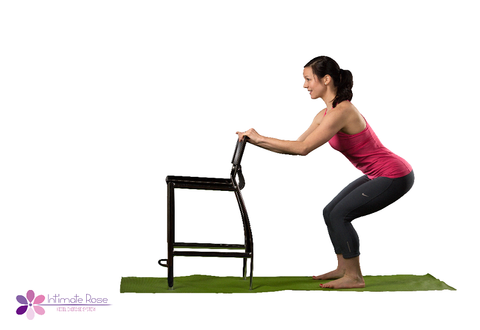Why Do Women Experience Urinary Incontinence, or Bladder Leakage?
Stress urinary incontinence (SUI) is the accidental leakage of urine while coughing, sneezing, laughing, or during physical exertion such as lifting something heavy or during exercises. SUI is often the result of weakened pelvic floor muscles, and generally responds well to pelvic floor strengthening exercises, referred to as Kegels.
The pelvic floor muscles may become weakened with pregnancy and vaginal birth, or with repetitive straining such as with chronic constipation, heavy lifting for prolonged periods, and with impact sports such as gymnastics, basketball, volleyball, running, and skiing.
What is a Kegel?
A Kegel is simply a contraction of the pelvic floor muscles, the sling-like muscles that surround and support the bladder, vagina and uterus, and rectum. Performing pelvic floor strengthening exercises (Kegels) can be helpful in training the muscles to treat bladder leaks, pelvic organ prolapse, and can improve female orgasm.
The proper way to perform Kegels for women, is to imagine shutting of the flow of urine. While your abdominal muscles will slightly tighten with this exercise, you want to avoid contracting your buttocks or pulling your abdominals in too tightly. Breathing is also highly important during this exercise.
Holding your breath will place pressure on the bladder and pelvic floor, thus making it very difficult to contract the muscles properly. The breathing pattern for this exercise is to inhale and remain relaxed, then exhale as if you were blowing out birthday candles, and simultaneously perform a Kegel.
How to Do Basic Kegels
To practice basic Kegels when you are beginning, start by lying on your back with knees bent and feet shoulder width apart, place your pelvis and low back in neutral alignment: this means that the pelvis is not rocked up or down, but is right in the middle.
You may wish to have a pillow under your head. To contract your pelvic floor muscles, visualize that the urethra, the area where urine comes out, is a telescope, and you are going to pull the telescope up and into your body using the pelvic floor muscles. This action properly tightens the pelvic floor muscles around the urethra- this is called a Kegel.
How Many Kegels Should I Do Each Day?
Research shows that 80 to 100 Kegels per day six days per week is required to get a woman dry who is experiencing bladder leakage. These numbers are also generally recommended for women experiencing vaginal prolapse as well as those looking to improve overall pelvic floor strength and stability.
These numbers are decreased if a Kegel exercise device that provides resistance is added. Kegel exercise devices such as the vaginal weights in the Intimate Rose Kegel Exercise System add resistance to the pelvic floor muscles. Because the pelvic floor muscles are working harder, fewer repetitions are required.
Once symptoms have resided, the bladder no longer leaks with exertion, or pressure is no longer felt in the pelvis from prolapse, the maintenance to ensure that symptoms do not return is 30 Kegels per day six days per week.
What is Pelvic Organ Prolapse (POP)?
Pelvic organ prolapse (POP) also referred to as vaginal prolapse, is a condition where the pelvic organs descend downward into the walls of the vagina. It occurs when there is weakness or injury in the supporting structures of the pelvic floor muscles or tendons. This allows one or more of the pelvic organs which are the bladder, uterus, and the rectum to move lower into the vagina, resulting in a sense of pressure in the vagina which can be very uncomfortable.
Pelvic organ prolapse can be caused by giving birth, though women who have not given birth can experience it as well. Conditions such as chronic constipation leads to repetitive straining of the pelvic floor muscles and may strain or cause weakness of the pelvic floor muscles resulting in prolapse.
Vaginal prolapse after hysterectomy is also common. This is because the bladder, uterus, and rectum all back up to each other in the pelvic bowl, and when the uterus is removed it leaves a void of space that the bladder and rectum may sink into resulting in prolapse.
Other causes include obesity, vigorous exercise or activity including heavy lifting, jumping, or running. Pelvic or abdominal surgery can also lead to weakness of the pelvic floor muscles resulting in prolapse.
Symptoms may arise at various points in life, from immediately after giving birth to a child, to later in life following menopause. Menopause brings with it a decrease in estrogen which leaves the walls of the vagina thinner, and the pelvic floor muscles weaker, generally making it more susceptible to prolapse.
Mild to moderate cases of pelvic organ prolapse can be treated with very specific pelvic floor muscle strengthening. It is often beneficial to see a pelvic floor physical therapy specialist, who can help to identify and treat other factors leading to prolapse and teach safe pelvic floor exercises (Kegels).
It is important to note that individuals with prolapse should not now, or ever do sit up or crunch exercises because they can lead to additional pressure, strain, and worsening of symptoms.
Questions to ask your gynecologist when you have Pelvic Organ Prolapse
Prolapse is often fixable with non-invasive measures. It is beneficial to ask your gynecologist for a referral to a pelvic floor physical therapist. The physical therapist will help you train your pelvic floor muscles to better support the organs by doing the right kind of Kegels and other exercises.
Additionally, the therapist will educate you on how avoid making the prolapse worse and will address any scar tissue in your abdomen or pelvis that might be contributing to your symptoms.
You may also ask your gynecologist if your prolapse is a good candidate for a pessary. Your gynecologist may be able to fit you for this vaginal device that supports pelvic organ prolapse in their office, or they may refer you to someone that can fit you.
If your gynecologist offers a surgical procedure as a treatment, it is always worth while to discuss non-surgical treatments discussed above. If you are unsure as to whether surgery is right for you, it is generally advised to get a second and possibly third opinion before you make your decision.
Beginning Pelvic Floor and Core Exercises

Avoid movement of the pelvis or bearing downward as if you were going to pass gas. It is also important to avoid holding your breath. While doing the exercise, inhale keeping the muscles relaxed, then exhale and simultaneously tighten the pelvic floor muscles.
Hold the contraction for 5 seconds, then rest for 5 seconds. Repeat 10 times. Do this 7-8 times every day.
Once you have mastered this after a few weeks, you can change the length of time that you hold the contraction, practicing quick and long hold Kegels:
Quick Kegel: Seated, contract your pelvic floor muscles as quickly and as tightly as you can for 1 second. Rest 5 seconds. Repeat 10 times. Repeat 3 times per day. Perform every day.
Long Kegel: When you are able to hold the Basic Kegel for 5 seconds easily, begin to increase hold time working towards a 10 second hold, followed by a 10 second rest. Perform 10 repetitions 3 times every day.
How Kegel Exercise Devices Help Get Results Faster
Using vaginal weights can produce faster and stronger results because the pelvic floor muscles receive added resistance and the weights help you identify where the muscles are so that you can be sure that you are performing Kegels properly.
The best Kegel exercise device to achieve bladder control and reduce pelvic organ prolapse is the Intimate Rose Kegel Exercise System. To find the proper weight to start your exercises with, begin by placing the white weight into the vagina just as you would do with a tampon.
Stand up and attempt to hold the weight inside your vagina for 1 minute. If this can be easily achieved, attempt to walk around doing light household chores with your clothing on as you normally would with the weight inserted for 10-15 minutes. If this can be achieved quite easily, attempt to do this with the next heaviest weight on the following day.
If the weight falls out into your underwear, go back down to the previous weight that you were able to maintain for 15 minutes. The pelvic floor muscles are actively engaged in order to keep the weight in. Continue this process daily until the weight that you are currently on is extremely easy and then move on to the next one. You can also do active Kegels and core exercises with the weight in as discussed below.

Beginning Kegel Exercises with Kegel Exercise Weights
Building strength in the pelvic floor can be done using basic exercises with the weights. You can place the weight in like a tampon to perform the Kegel exercises described in the basic Kegel exercises video You can also use basic changes in body position to build up strength to stop bladder leakage.
How the Kegel Exercise Weights can be used to get even better results during higher exertion physical activity
To train the pelvic floor muscles to react quickly to prevent urine leakage during higher exertional activities of daily living such as exercising and lifting heavy objects, it is necessary to train them during such tasks. The goal of these exercises is to build coordination and control of the pelvic floor muscles during common motions found in daily tasks such as walking, climbing stairs, and grocery shopping.
To do this, place in the vaginal weight that you were able to maintain for 20 minutes as described before, and perform the following exercises three times per day 5-6 days per week.
Advanced Pelvic Floor Exercises
Standing Kegel: With the weight in, stand up tall with good posture, feet standing hip width apart.

Inhale and relax. Then exhale, and simultaneously do a Kegel, holding the Kegel while exhaling for 5 seconds. Inhale and relax. Repeat 10 times.
Standing Heel Raise Kegel: Stand at your kitchen counter for support with vaginal weight in.

Inhale and relax. Exhale and simultaneously do a Kegel and slowly raise up onto the balls of your feet and then come back down with control. Once your feet are flat on the floor again, inhale and relax the pelvic floor, then exhale and repeat. You should feel the Kegel throughout the entire process of raising up onto the toes and lowering back down. Repeat 10 times.
Standing side kick: Stand at your kitchen counter for balance and support with the vaginal weight in.

Inhale and relax. Exhale and simultaneously do a Kegel, then bend your knees to approximately 45 degrees while pressing your hips backward as if you were going to sit in a chair. Maintaining the Kegel, return to standing. The Kegel and the gentle exhale should be maintained throughout the entire duration of movement. Once you return to standing, inhale and relax. Repeat 10 times.
Bladder leakage and pelvic organ prolapse are curable issues. There is no need to suffer, and improving your pelvic floor muscle strength is achievable with just a few minutes each day. Using a Kegel exercise device is a practical way get results quicker.
If you have scar tissue or pelvic pain, ask your doctor for a referral to a qualified pelvic floor physical therapist to help you address these issues and provide you with safe and effective exercises to reach your goals. Imagine the possibilities of eliminating bladder leakage and returning to the activities that you love.

